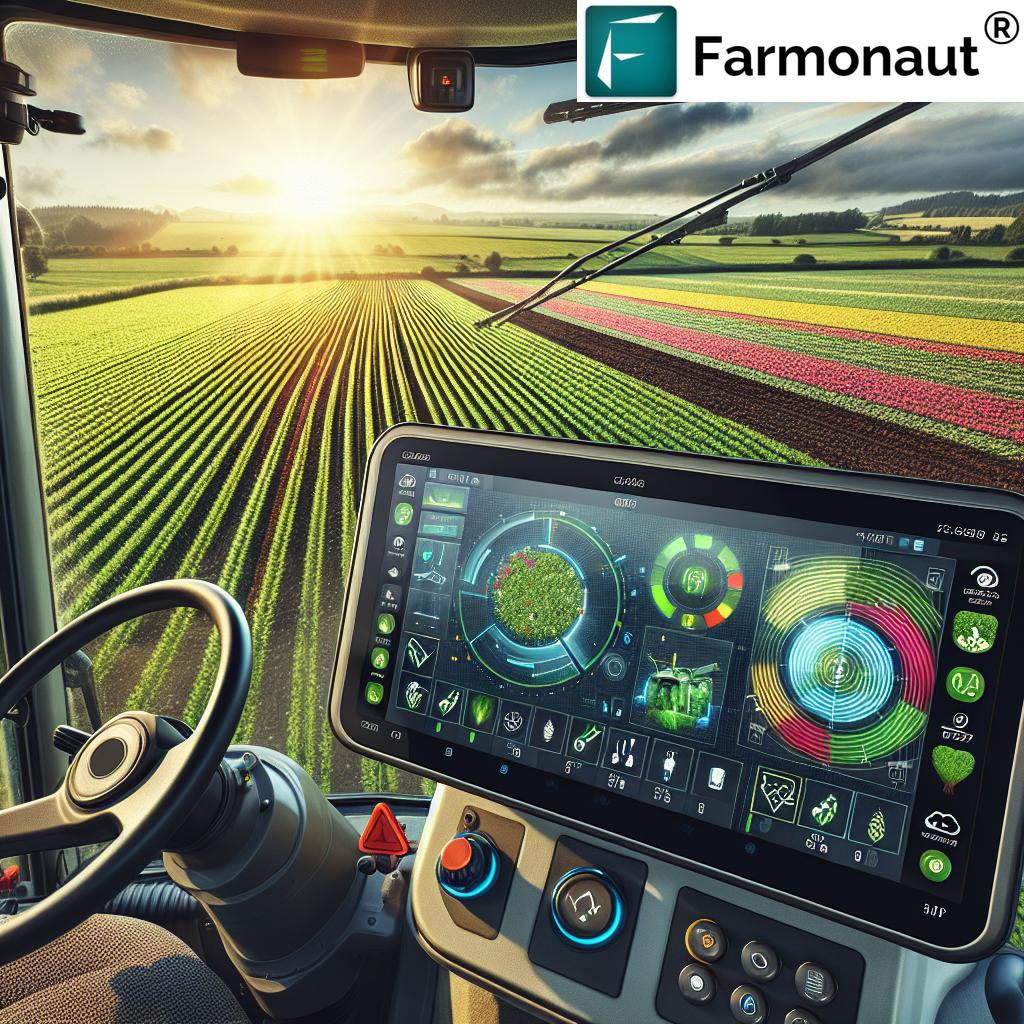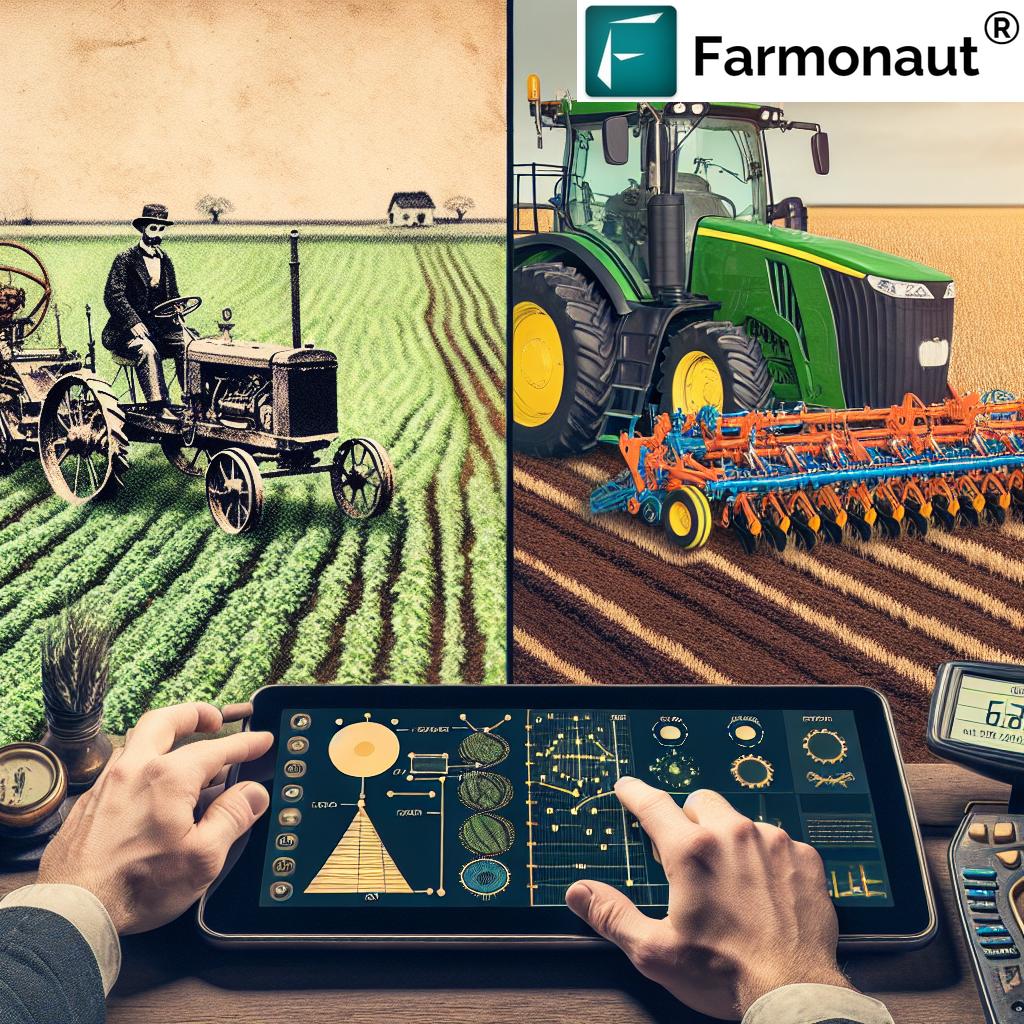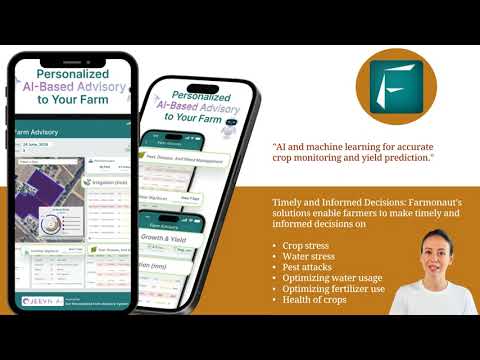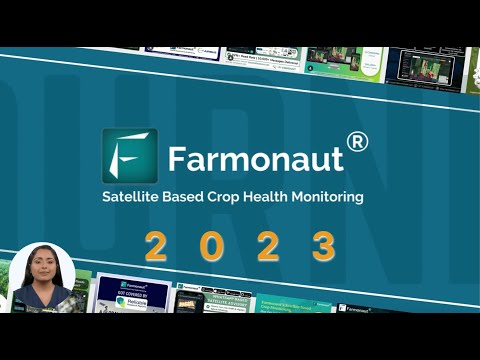Revolutionizing Precision Agriculture: How Smart Farming Solutions Boost Productivity and Efficiency
“Precision agriculture technology can reduce input waste by up to 30% through variable-rate application in farming.”
In the ever-evolving landscape of modern agriculture, we are witnessing a remarkable transformation driven by cutting-edge technologies and innovative approaches. As we delve into the world of smart farming solutions, we’ll explore how these advancements are revolutionizing the way we cultivate our lands and manage our crops. From state-of-the-art tractor control centers to sophisticated data management systems, the future of farming is here, and it’s more efficient and productive than ever before.
The Dawn of Precision Agriculture Technology
Precision agriculture technology has emerged as a game-changer in the farming industry. By leveraging advanced tools and techniques, farmers can now make data-driven decisions that optimize yield potential while minimizing waste. This approach not only enhances productivity but also promotes sustainability in agriculture.
- GPS-based field prescriptions
- Variable-rate application in farming
- Smart farming solutions
- Agricultural telemetry systems
These technologies form the cornerstone of modern precision agriculture, enabling farmers to tailor their practices to the specific needs of each field and crop.

Farm Equipment Automation: The New Frontier
Farm equipment automation is at the forefront of agricultural innovation. Modern tractors are no longer just powerful machines; they’ve become intelligent hubs for precision agriculture. Equipped with advanced control centers and ISOBUS compatibility, these tractors are transforming the way we approach farming tasks.
Key features of automated farm equipment include:
- Touchscreen tractor displays
- Intuitive user interfaces
- Comprehensive recordkeeping capabilities
- Real-time data collection and analysis
These advancements not only simplify operations but also provide farmers with unprecedented control and insight into their agricultural practices.
Agricultural Data Management: The Backbone of Smart Farming
Effective agricultural data management is crucial for making informed decisions on the farm. With the integration of smart farming solutions, producers can now collect, analyze, and act upon a wealth of information in real-time.
Some key aspects of agricultural data management include:
- Crop health monitoring
- Soil moisture analysis
- Weather pattern tracking
- Yield prediction models
By harnessing the power of data, farmers can optimize their inputs, reduce waste, and maximize their yields.
ISOBUS Compatible Tractors: Streamlining Farm Operations
ISOBUS compatibility has revolutionized the way tractors and implements communicate. This universal protocol allows for seamless integration between different brands of equipment, providing farmers with unprecedented flexibility and efficiency in their operations.
Benefits of ISOBUS compatible tractors include:
- Simplified equipment setup
- Reduced operator fatigue
- Enhanced implement control
- Improved data exchange
With ISOBUS technology, farmers can focus more on their crops and less on managing complex equipment interfaces.
Variable-Rate Application in Farming: Precision at Its Finest
Variable-rate application (VRA) technology allows farmers to apply inputs such as fertilizers, pesticides, and seeds with pinpoint accuracy. This precision agriculture technique ensures that each area of the field receives exactly what it needs, no more and no less.
Key advantages of VRA include:
- Reduced input costs
- Minimized environmental impact
- Optimized crop yields
- Improved resource management
By adopting VRA, farmers can significantly enhance their productivity while promoting sustainable farming practices.

“Modern tractors equipped with GPS-based field prescriptions can increase yield potential by 15% compared to traditional methods.”
GPS-Based Field Prescriptions: Mapping the Future of Farming
GPS-based field prescriptions have transformed the way farmers approach field management. By creating detailed maps of soil characteristics, crop health, and yield potential, farmers can develop tailored strategies for each section of their fields.
Applications of GPS-based field prescriptions include:
- Precise seeding rates
- Targeted fertilizer application
- Efficient irrigation management
- Accurate yield forecasting
This technology enables farmers to make data-driven decisions that optimize their resources and maximize their yields.
Farm Fleet Monitoring Systems: Efficiency in Motion
Farm fleet monitoring systems provide real-time insights into the operation and performance of agricultural machinery. These systems help farmers manage their equipment more effectively, reducing downtime and improving overall efficiency.
Key features of farm fleet monitoring systems include:
- Real-time location tracking
- Fuel consumption monitoring
- Maintenance scheduling
- Performance analytics
By leveraging these systems, farmers can optimize their machinery usage and reduce operational costs.
Touchscreen Tractor Displays: User-Friendly Interfaces for Modern Farming
Touchscreen tractor displays have revolutionized the operator experience in modern agricultural machinery. These intuitive interfaces provide easy access to a wealth of information and controls, streamlining farm operations.
Benefits of touchscreen tractor displays include:
- Simplified menu navigation
- Customizable layouts
- Enhanced visibility in various lighting conditions
- Integration with precision farming tools
With these advanced displays, operators can manage complex tasks with ease, improving overall productivity on the farm.
Smart Farming Solutions: Integrating Technology for Better Results
Smart farming solutions encompass a wide range of technologies and practices designed to enhance agricultural productivity and sustainability. By integrating various precision agriculture tools, farmers can create comprehensive systems that optimize every aspect of their operations.
Components of smart farming solutions include:
- Automated irrigation systems
- Drone-based crop monitoring
- AI-powered decision support tools
- Blockchain for supply chain transparency
These integrated solutions are paving the way for a more efficient and sustainable future in agriculture.
Agricultural Telemetry Systems: Real-Time Insights for Informed Decisions
Agricultural telemetry systems provide farmers with real-time data on various aspects of their operations. From soil conditions to equipment performance, these systems offer valuable insights that enable quick and informed decision-making.
Key applications of agricultural telemetry include:
- Remote monitoring of crop health
- Early detection of pest and disease outbreaks
- Optimization of irrigation schedules
- Tracking of livestock health and behavior
By leveraging telemetry data, farmers can respond promptly to changing conditions and optimize their farming practices.
The Role of Farmonaut in Precision Agriculture
In the realm of precision agriculture, Farmonaut stands out as a pioneering force, offering advanced satellite-based farm management solutions. Through its innovative platform, Farmonaut is making precision agriculture more accessible and affordable for farmers worldwide.
Key offerings from Farmonaut include:
- Real-time crop health monitoring
- AI-based advisory systems
- Blockchain-based traceability
- Resource management tools
By leveraging cutting-edge technologies like satellite imagery, artificial intelligence, and blockchain, Farmonaut is empowering farmers to make data-driven decisions that optimize their yields and promote sustainable farming practices.
Explore Farmonaut’s solutions:
The Future of Precision Agriculture: Trends and Innovations
As we look to the future of precision agriculture, several exciting trends and innovations are emerging that promise to further revolutionize farming practices:
- Internet of Things (IoT) sensors for hyper-local data collection
- Machine learning algorithms for predictive crop management
- Robotics and autonomous vehicles for labor-intensive tasks
- Vertical farming and controlled environment agriculture
- Gene editing technologies for crop improvement
These advancements will continue to push the boundaries of what’s possible in agriculture, driving increased productivity, sustainability, and resilience in the face of global challenges.
Precision Agriculture Technologies Comparison
| Technology Name | Primary Function | Key Benefits | Estimated Productivity Increase |
|---|---|---|---|
| GPS-guided field prescriptions | Create detailed field maps for targeted treatments | Optimized resource allocation, reduced input waste | 10-20% |
| Variable-rate application systems | Apply inputs at varying rates across fields | Improved crop yields, reduced environmental impact | 15-30% |
| ISOBUS-compatible equipment | Standardize communication between tractors and implements | Simplified operation, improved data exchange | 5-15% |
| Touchscreen tractor displays | Provide user-friendly interface for equipment control | Enhanced operator efficiency, reduced fatigue | 8-18% |
| Agricultural telemetry systems | Collect and transmit real-time farm data | Improved decision-making, early problem detection | 12-25% |
Overcoming Challenges in Adopting Precision Agriculture
While the benefits of precision agriculture are clear, there are challenges that farmers may face when adopting these technologies:
- Initial investment costs
- Learning curve for new technologies
- Data management and privacy concerns
- Integration with existing farm equipment
- Reliable internet connectivity in rural areas
Addressing these challenges is crucial for the widespread adoption of precision agriculture technologies. Industry leaders, policymakers, and technology providers must work together to create solutions that make these innovations accessible to farmers of all scales.
The Economic Impact of Smart Farming Solutions
The adoption of smart farming solutions has significant economic implications for the agricultural sector:
- Increased crop yields and quality
- Reduced input costs (fertilizers, pesticides, water)
- Improved labor efficiency
- Enhanced market competitiveness
- New revenue streams through data monetization
As these technologies become more widespread, we can expect to see a transformation in the economics of farming, with precision agriculture playing a key role in ensuring the profitability and sustainability of agricultural operations.
Environmental Benefits of Precision Agriculture
Precision agriculture not only boosts productivity but also contributes significantly to environmental conservation:
- Reduced use of chemical inputs
- Improved water management and conservation
- Decreased soil erosion and compaction
- Lower greenhouse gas emissions
- Enhanced biodiversity through targeted land management
By adopting precision agriculture techniques, farmers can play a crucial role in promoting sustainable farming practices and mitigating the environmental impact of agriculture.
The Role of Big Data in Modern Agriculture
Big data analytics is revolutionizing decision-making in agriculture. By collecting and analyzing vast amounts of data from various sources, farmers and agribusinesses can gain unprecedented insights into their operations:
- Predictive analytics for crop yields
- Risk assessment and management
- Optimization of supply chains
- Personalized crop management strategies
- Market trend analysis and forecasting
The power of big data in agriculture lies in its ability to turn information into actionable insights, enabling more informed and timely decision-making at every level of the farming process.
Integrating Precision Agriculture with Sustainable Farming Practices
Precision agriculture and sustainable farming go hand in hand, offering a path to more efficient and environmentally friendly food production:
- Conservation tillage techniques
- Integrated pest management
- Precision irrigation systems
- Cover cropping and crop rotation
- Nutrient management planning
By combining precision agriculture technologies with sustainable farming practices, producers can achieve a balance between productivity and environmental stewardship.
The Global Impact of Smart Farming Solutions
The adoption of smart farming solutions has far-reaching implications for global food security and agricultural sustainability:
- Increased food production to meet growing global demand
- Resilience to climate change and extreme weather events
- Reduction in food waste through improved supply chain management
- Empowerment of smallholder farmers in developing countries
- Promotion of sustainable agricultural practices on a global scale
As these technologies become more accessible worldwide, they have the potential to transform agriculture and address some of the most pressing challenges facing our global food systems.
Farmonaut: Empowering Farmers with Advanced Technology
Farmonaut’s commitment to making precision agriculture accessible is reflected in its comprehensive suite of tools and services:
- Satellite-based crop health monitoring for real-time insights
- AI-powered advisory system for personalized farming recommendations
- Blockchain-based traceability solutions for supply chain transparency
- Resource management tools for optimizing farm operations
- Carbon footprint tracking for sustainable agriculture practices
By leveraging these advanced technologies, Farmonaut is helping farmers around the world to improve their productivity, sustainability, and profitability.
Explore Farmonaut’s API for developers:
Conclusion: Embracing the Future of Agriculture
As we’ve explored throughout this article, precision agriculture and smart farming solutions are revolutionizing the agricultural landscape. From GPS-guided field prescriptions to advanced telemetry systems, these technologies are empowering farmers to do more with less, maximizing productivity while promoting sustainability.
The integration of data-driven insights, automation, and cutting-edge equipment is creating a new era of farming that is more efficient, productive, and environmentally friendly than ever before. As these technologies continue to evolve and become more accessible, we can expect to see even greater advancements in the field of agriculture.
Companies like Farmonaut are at the forefront of this agricultural revolution, providing innovative solutions that make precision agriculture accessible to farmers of all scales. By embracing these smart farming solutions, we are not only enhancing farm productivity and efficiency but also paving the way for a more sustainable and food-secure future.
As we look ahead, it’s clear that the future of agriculture is smart, data-driven, and precision-focused. By continuing to innovate and adopt these technologies, we can ensure that our agricultural practices are not only meeting the needs of today but are also prepared for the challenges of tomorrow.
FAQ Section
Q: What is precision agriculture?
A: Precision agriculture is an approach to farm management that uses information technology and data-driven insights to optimize crop yields and reduce input waste. It involves technologies such as GPS guidance, control systems, sensors, robotics, drones, autonomous vehicles, variable rate technology, and software.
Q: How does variable-rate application benefit farmers?
A: Variable-rate application allows farmers to apply inputs like fertilizers, pesticides, and seeds at varying rates across a field, based on specific needs of different areas. This results in optimized use of resources, reduced input costs, minimized environmental impact, and potentially increased crop yields.
Q: What is ISOBUS and why is it important?
A: ISOBUS is a universal protocol for electronic communication between implements, tractors, and computers. It’s important because it allows equipment from different manufacturers to communicate with each other, simplifying the operation of farm machinery and enabling seamless data exchange.
Q: How do GPS-based field prescriptions work?
A: GPS-based field prescriptions use satellite technology to create detailed maps of field characteristics such as soil type, nutrient levels, and crop health. These maps are then used to develop tailored strategies for each section of the field, allowing for precise application of inputs and optimized crop management.
Q: What role does big data play in smart farming?
A: Big data in smart farming involves collecting, processing, and analyzing large volumes of data from various sources such as sensors, satellites, and weather stations. This data is used to make informed decisions about crop management, predict yields, optimize resource use, and improve overall farm efficiency.
Q: How can farmers overcome the challenges of adopting precision agriculture technologies?
A: Farmers can overcome adoption challenges by starting small and gradually integrating technologies, seeking education and training opportunities, collaborating with agricultural technology providers, and exploring financial assistance options such as grants or subsidies for technology adoption.
Q: What are the environmental benefits of precision agriculture?
A: Precision agriculture offers several environmental benefits, including reduced use of chemicals and water, decreased soil erosion and compaction, lower greenhouse gas emissions, and improved biodiversity through more targeted land management practices.
Q: How does Farmonaut contribute to precision agriculture?
A: Farmonaut provides advanced satellite-based farm management solutions that include real-time crop health monitoring, AI-based advisory systems, blockchain-based traceability, and resource management tools. These solutions help make precision agriculture more accessible and affordable for farmers worldwide.






